Unit9 Sea water and rain water 第2课时 语法知识及拓展(课件)(共21张PPT)
文档属性
| 名称 | Unit9 Sea water and rain water 第2课时 语法知识及拓展(课件)(共21张PPT) |  | |
| 格式 | pptx | ||
| 文件大小 | 315.9KB | ||
| 资源类型 | 试卷 | ||
| 版本资源 | 牛津上海版(试用本) | ||
| 科目 | 英语 | ||
| 更新时间 | 2022-05-20 22:44:06 | ||
图片预览



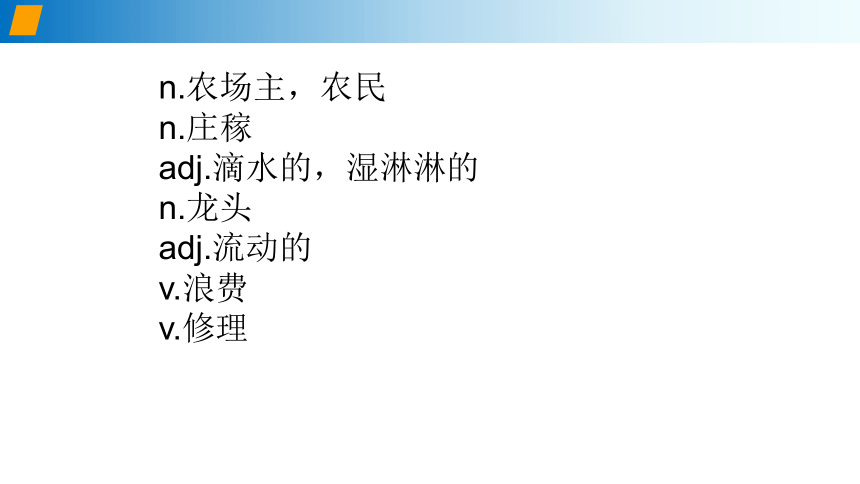
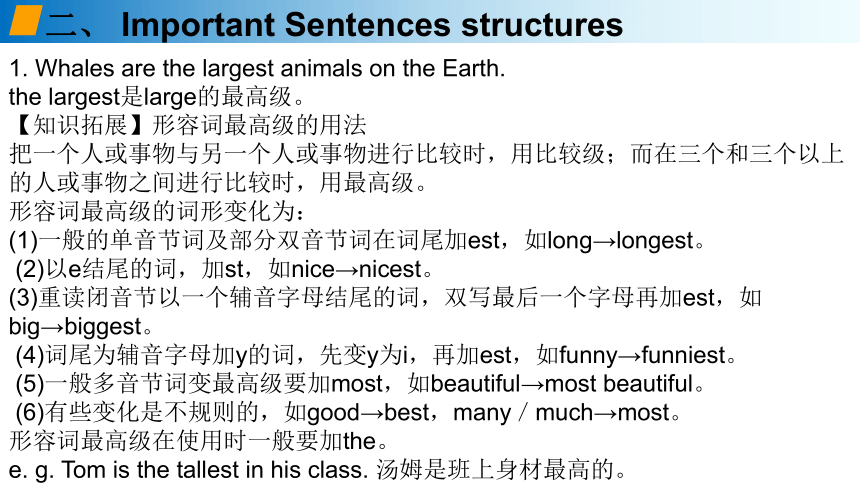
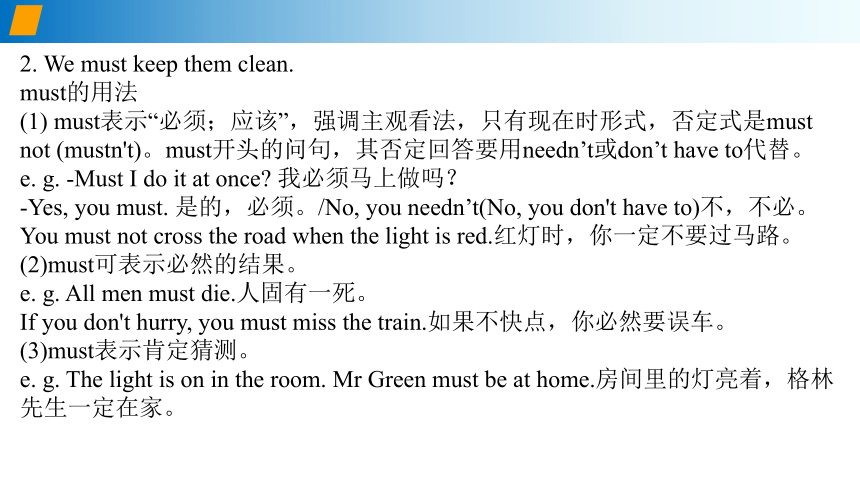
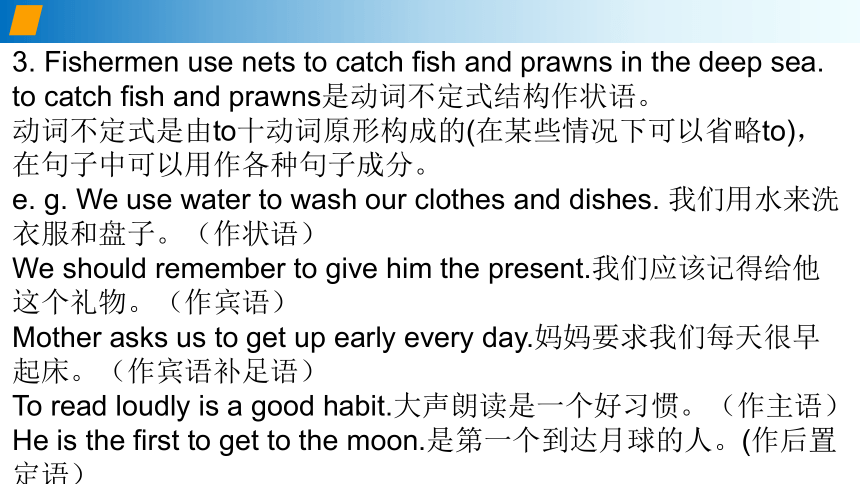
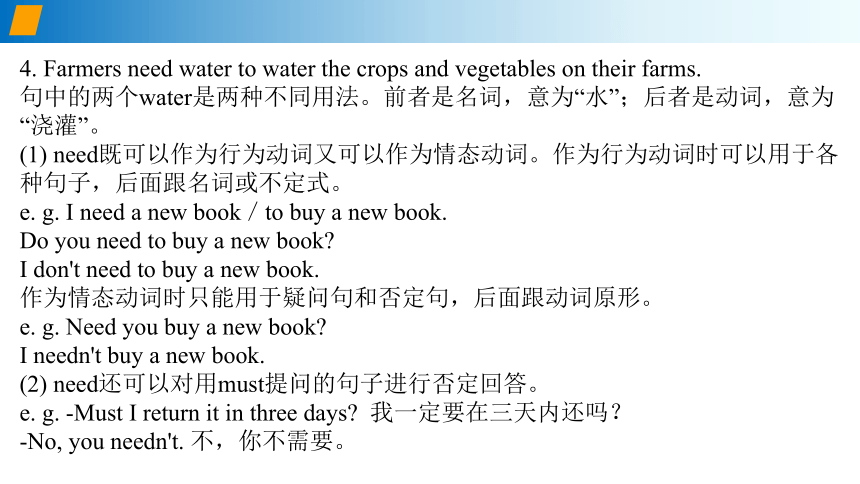
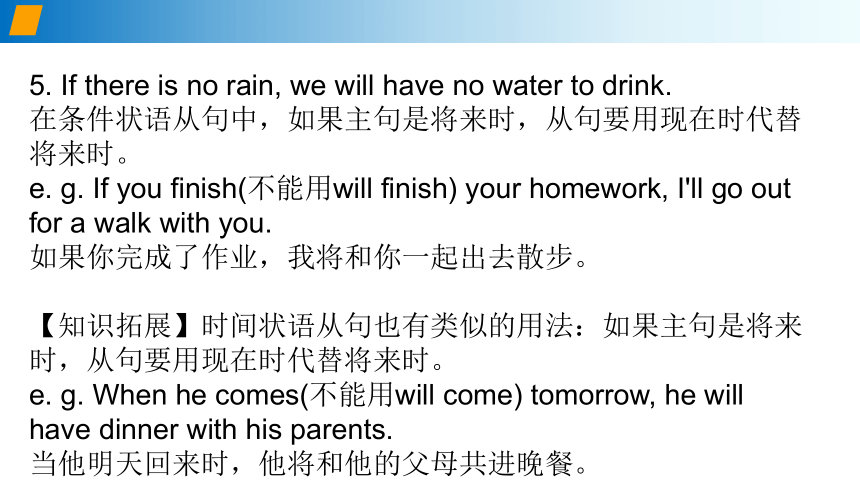
文档简介
(共21张PPT)
Lead in— 学海拾贝
Well begun is half done.
良好的开端是成功的一半。
沪教版 英语 六年级 第二学期
Unit9
Sea water and rain water
一、知识回顾
1. 单词默写。
n.海星
n.海马
n.竞争;竞赛,比赛
n.小溪,河流
adj.聪明的;有智慧的
n.渔夫
adj.重要的
n. 覆盖
n.因特网
v.淋浴 n. 淋浴; 淋浴装置
n.农场主,农民
n.庄稼
adj.滴水的,湿淋淋的
n.龙头
adj.流动的
v.浪费
v.修理
二、 Important Sentences structures
1. Whales are the largest animals on the Earth.
the largest是large的最高级。
【知识拓展】形容词最高级的用法
把一个人或事物与另一个人或事物进行比较时,用比较级;而在三个和三个以上的人或事物之间进行比较时,用最高级。
形容词最高级的词形变化为:
(1)一般的单音节词及部分双音节词在词尾加est,如long→longest。
(2)以e结尾的词,加st,如nice→nicest。
(3)重读闭音节以一个辅音字母结尾的词,双写最后一个字母再加est,如big→biggest。
(4)词尾为辅音字母加y的词,先变y为i,再加est,如funny→funniest。
(5)一般多音节词变最高级要加most,如beautiful→most beautiful。
(6)有些变化是不规则的,如good→best,many/much→most。
形容词最高级在使用时一般要加the。
e. g. Tom is the tallest in his class. 汤姆是班上身材最高的。
2. We must keep them clean.
must的用法
(1) must表示“必须;应该”,强调主观看法,只有现在时形式,否定式是must not (mustn't)。must开头的问句,其否定回答要用needn’t或don’t have to代替。
e. g. -Must I do it at once 我必须马上做吗?
-Yes, you must. 是的,必须。/No, you needn’t(No, you don't have to)不,不必。
You must not cross the road when the light is red.红灯时,你一定不要过马路。
(2)must可表示必然的结果。
e. g. All men must die.人固有一死。
If you don't hurry, you must miss the train.如果不快点,你必然要误车。
(3)must表示肯定猜测。
e. g. The light is on in the room. Mr Green must be at home.房间里的灯亮着,格林先生一定在家。
3. Fishermen use nets to catch fish and prawns in the deep sea.
to catch fish and prawns是动词不定式结构作状语。
动词不定式是由to十动词原形构成的(在某些情况下可以省略to),在句子中可以用作各种句子成分。
e. g. We use water to wash our clothes and dishes. 我们用水来洗衣服和盘子。(作状语)
We should remember to give him the present.我们应该记得给他这个礼物。(作宾语)
Mother asks us to get up early every day.妈妈要求我们每天很早起床。(作宾语补足语)
To read loudly is a good habit.大声朗读是一个好习惯。(作主语)
He is the first to get to the moon.是第一个到达月球的人。(作后置定语)
4. Farmers need water to water the crops and vegetables on their farms.
句中的两个water是两种不同用法。前者是名词,意为“水”;后者是动词,意为“浇灌”。
(1) need既可以作为行为动词又可以作为情态动词。作为行为动词时可以用于各种句子,后面跟名词或不定式。
e. g. I need a new book/to buy a new book.
Do you need to buy a new book
I don't need to buy a new book.
作为情态动词时只能用于疑问句和否定句,后面跟动词原形。
e. g. Need you buy a new book
I needn't buy a new book.
(2) need还可以对用must提问的句子进行否定回答。
e. g. -Must I return it in three days 我一定要在三天内还吗?
-No, you needn't. 不,你不需要。
5. If there is no rain, we will have no water to drink.
在条件状语从句中,如果主句是将来时,从句要用现在时代替将来时。
e. g. If you finish(不能用will finish) your homework, I'll go out for a walk with you.
如果你完成了作业,我将和你一起出去散步。
【知识拓展】时间状语从句也有类似的用法:如果主句是将来时,从句要用现在时代替将来时。
e. g. When he comes(不能用will come) tomorrow, he will have dinner with his parents.
当他明天回来时,他将和他的父母共进晚餐。
三、语法讲解
动名词的用法
(1)除了以前出现的动名词作宾语的用法外,介词后面的宾语如果用动词,也一定要用动名词的形式。
e. g. I use water for brushing my teeth. 我用水刷牙。(for是介词,所以brush要用动名词的形式)
(2)动名词的否定形式是在动名词前加上not。
e. g. We can keep healthy by not eating too much meat. 我们可以通过少吃肉的办法保持健康。
Rewrite the following sentences(改写句子)
1.You need to look after your little sister. (改为否定句)
You ______ ______ to look after your little sister.
2.He cut down the trees to make a house.(改为一般疑问句)
______ he ______ down the trees to make a house.
3.It’s about two hundred meters from my home to school. (对划线部分提问)
______ ______ is it from my home to school.
4.They have stayed in this city since ten years ago.(对划线部分提问)
______ ______ have they stayed in this city.
5.You mustn’t swim here. (保持句意不变)
______ is not ______ here.
6.museum, railway station, a, now, old, is used for, The (连词成句)
____________________________________________
【当堂检测】
1. don’t need
2. Did cut
3. How far
4. How long
5. Swimming allowed
6.The old railway station is used for a museum now.
【解析】
1.原句中need后接动词不定式作宾语,可知此处need为实义动词,对实义动词进行否定要借助助动词;根据主语you为第二人称,可知助动词用do;又其前有助动词,其后动词用原形,故答案为don’t need。
2.根据原句动词cut为一般过去时,可知一般疑问句用助动词did放在句首进行提问;句首有助动词,其后动词用原形,故答案为Did; cut。
3.划线部分为距离,对距离提问要用how far,意为“多远”,故答案为How far。
4.划线部分表示时间长短,对时间长度提问应该用how long,意为“多长时间”,故答案为How long。
5.原句句意可表示为“此处游泳不被允许”,可知要用被动语态be done;swimming意为“游泳”,动名词作主语,allow意为“允许”,是动词,其过去分词为allowed,故答案为Swimming; allowed。
6.句意:这个旧火车站如今被用于一个博物馆。
根据所给单词,可知这是一个一般现在时的肯定句;railway station作主语,其前被定冠词the限定,被定语old修饰;is used for意为“用于”,museum意为“博物馆”,作介词for的宾语,其前被不定冠词a限定,now作时间状语放在句末,故答案为The old railway station is used for a museum now.
7.Tom enjoys ________ in the library on Saturdays.
A.read B.reading C.to read D.reads
8.She ________ in the ________ pool last weekend.
A.swims; swimming B.swam; swim C.swam; swam D.swam; swimming
9.Look! The children are having a great time ________ a snowman in the snow.
A.make B.makes C.making D.to make
10.Bill is good at ________ stories. The children like him very much.
A.speak B.telling C.speaking D.tell
11.Tom usually ________ his teeth after ________. It is a good habit.
A.brush; eating B.brushes; eating C.brush; eats D.brushes; to eat
7.B
【详解】
句意:汤姆喜欢星期六在图书馆看书。
考查非谓语动词。enjoy doing sth“喜欢做某事”,动名词作宾语,故选B。
8.D
【详解】
句意:她上周末在游泳池游泳。
考查时态和动名词。根据“last weekend”可知,时态为一般过去时,动词要用过去式;swim的过去式为swam,排除A项;再根据“pool”可知,第二空表示“游泳池”,应用swimming来修饰。故选D。
9.C
【详解】
句意:看!孩子们在雪地里堆雪人玩得很开心。
考查非谓语动词。have a great time doing sth.“做某事玩得很开心”,动名词作宾语。故选C。
10.B
【详解】
句意:比尔擅长讲故事。孩子们非常喜欢他。
考查动名词和动词辨析。tell讲述;speak说。根据“Bill is good at”可知,be good at doing sth.“擅长做某事”,此空使用动名词。tell stories“讲故事”,故选B。
11.B
【详解】
句意:汤姆通常饭后刷牙。这是一个好习惯。
考查主谓一致及动名词。句子主语是第三人称单数,时态为一般现在时,所以空一处动词用三单形式,排除选项A和C;介词after后用动名词作宾语,所以排除选项D。故选B。
12.Can you finish ______ the book in about a week.
A.reading B.read C.write D.writes
13.I enjoy ________ an English story before I go to bed.
A.read B.reads C.reading D.to read
14.My parents expect ________ sitcoms but I can’t stand ________ them.
A.to watch; to watch B.to watch; watching C.watching; watching D.watching; to watch
15.How about ________ there by subway
A.go B.to go C.goes D.going
16.My old neighbor Charles enjoys ________ photos. He always goes out with his camera.
A.taking B.took C.take D.to take
12.A
【详解】
句意:你能在大约一周的时间内读完这本书吗?
考查非谓语。finish doing sth“完成做某事”,固定短语,动名词做finish的宾语。故选A。
13.C
【详解】
句意:我喜欢在睡觉前读一个英语故事。
考查非谓语动词。enjoy doing sth“喜欢做某事”,动名词作宾语,故选C。
14.B
【详解】
句意:我父母希望去看情景喜剧,但我无法忍受去看它们。
考查非谓语动词。根据固定搭配expect to do sth.“期待做某事”和can’t stand doing sth.“不能忍受做某事”可知,B项正确。故选B。
15.D
【详解】
句意:乘地铁去怎么样?
考查非谓语动词。how about doing sth.“做某事怎么样”,介词about后接动名词going。故选D。
16.A
【详解】
句意:我的老邻居查尔斯喜欢拍照。他总是带着照相机出去。
考查非谓语动词。结合语境和空前“enjoys”可知这里用“enjoy doing sth喜欢做某事”,所以此处用take的ing形式,作宾语。故选A。
17.We are all looking forward ________ you again.
A.to see B.to seeing C.for see D.for seeing
18.My mother ________to dance. But she enjoys _________ now.
A.used, sing B.uses, sings C.use, sing D.used, singing
19.—Does your sister like ________
—Yes, she does. But she ________ swim very well.
A.swimming; can B.swim; can C.swimming; can’t D.swim; can
20.Johnny keeps ________ for two hours before he goes to bed every day.
A.study B.studies C.studying D.to study
21.—Your English is really great. How do you study English
—I join the English club and enjoy ________ English every day.
A.speaking B.to speak C.speak D.spoke
17.B【详解】
句意:我们都盼望再见到你。
考查介词和动名词。根据句意可知,这句话中使用了短语look forward to…意为“盼望,期待”,to为介词,后面跟名词或动名词形式。故选B。
18.D【详解】
句意:我的妈妈过去常常跳舞,但是她现在喜欢唱歌。
考查一般过去时。used使用,为一般过去时;uses使用,为一般现在时第三人称单数形式;use使用,为一般现在时。根据后文“now”可知,前文用used表示“过去常常做某事”。enjoy doing sth“喜欢做某事”,故填singing。故选D。
19.C【详解】
句意:——你的妹妹喜欢游泳吗?——是的,她喜欢。但是她游泳游得不好。
考查动名词作宾语和情态动词。根据“like doing”可知,需要动名词作宾语,因此第一空swimming符合句意;再者根据“But”可知,游泳不好,因此第二空can’t符合句意。故选C。
20.C【详解】
句意:约翰尼每天睡觉前都要学习两个小时。
考查非谓语动词。keep doing sth“持续做某事”,动名词作宾语,故选C。
21.A【详解】
句意:——你的英语真地很棒。你是怎样学习英语的?——我加入了英语俱乐部,喜欢每天说英语。
考查非谓语动词。enjoy doing sth.“喜欢干某事”,固定用法,所以空处应用动名词作宾语。故选A。
22.Lily is having a good time ________ the bird’s Nest with her friends.
A.visits B.to visit C.visiting D.to visiting
23.We can save time by ________ a taxi instead of a bus.
A.take B.taking C.not take D.not taking
24.I used to _________ football after school, but now I enjoy _________.
A.play; swimming B.playing; swimming C.playing; swim D.play; swim
25.How about ________ some photos It is so beautiful here.
A.to take B.took C.taking D.taken
26.Li Ming used ________ on the right in China, but he soon got used ________ on the left in England.
A.to drive; to drive B.driving; driving
C.to driving; to drive D.to drive; to driving
22.C
【详解】
句意:莉莉和她的朋友们在鸟巢玩得很开心。
考查非谓语动词。固定短语have a good time doing sth.“做某事很开心”。故选C。
23.B
【详解】
句意:我们可以通过乘坐出租车而不是汽车来节省时间。
考查非谓语动词。by是介词“通过”,介词后跟动名词形式作宾语,排除AC;根据后文“instead of a bus”可知,乘坐出租车而不是汽车。故选B。
24.A
【详解】
句意:我以前放学后踢足球,但现在我喜欢游泳。
考查非谓语动词。used to do sth.“过去常常做某事”,第一空用play;enjoy doing sth.“喜欢做某事”,第二空用swimming。故选A。
25.C
【详解】
句意:拍些照片怎么样?这里是如此美丽。
考查动名词作宾语。根据“how about doing sth.”可知,需要一个动名词作宾语。故选C。
26.D
【详解】
句意:李明以前在中国靠右开车,但他很快就习惯了在英国靠左开车。
考查非谓语动词。drive“驾驶”,动词原形;driving“驾驶”,动词的现在分词/动名词。固定短语used to do sth.“过去常常做某事”,其后跟动词原形,故排除B选项;固定短语get used to doing sth.“习惯做某事”,其后跟动名词。故选D。
愿君皆有所获,皆有所得
Lead in— 学海拾贝
Well begun is half done.
良好的开端是成功的一半。
沪教版 英语 六年级 第二学期
Unit9
Sea water and rain water
一、知识回顾
1. 单词默写。
n.海星
n.海马
n.竞争;竞赛,比赛
n.小溪,河流
adj.聪明的;有智慧的
n.渔夫
adj.重要的
n. 覆盖
n.因特网
v.淋浴 n. 淋浴; 淋浴装置
n.农场主,农民
n.庄稼
adj.滴水的,湿淋淋的
n.龙头
adj.流动的
v.浪费
v.修理
二、 Important Sentences structures
1. Whales are the largest animals on the Earth.
the largest是large的最高级。
【知识拓展】形容词最高级的用法
把一个人或事物与另一个人或事物进行比较时,用比较级;而在三个和三个以上的人或事物之间进行比较时,用最高级。
形容词最高级的词形变化为:
(1)一般的单音节词及部分双音节词在词尾加est,如long→longest。
(2)以e结尾的词,加st,如nice→nicest。
(3)重读闭音节以一个辅音字母结尾的词,双写最后一个字母再加est,如big→biggest。
(4)词尾为辅音字母加y的词,先变y为i,再加est,如funny→funniest。
(5)一般多音节词变最高级要加most,如beautiful→most beautiful。
(6)有些变化是不规则的,如good→best,many/much→most。
形容词最高级在使用时一般要加the。
e. g. Tom is the tallest in his class. 汤姆是班上身材最高的。
2. We must keep them clean.
must的用法
(1) must表示“必须;应该”,强调主观看法,只有现在时形式,否定式是must not (mustn't)。must开头的问句,其否定回答要用needn’t或don’t have to代替。
e. g. -Must I do it at once 我必须马上做吗?
-Yes, you must. 是的,必须。/No, you needn’t(No, you don't have to)不,不必。
You must not cross the road when the light is red.红灯时,你一定不要过马路。
(2)must可表示必然的结果。
e. g. All men must die.人固有一死。
If you don't hurry, you must miss the train.如果不快点,你必然要误车。
(3)must表示肯定猜测。
e. g. The light is on in the room. Mr Green must be at home.房间里的灯亮着,格林先生一定在家。
3. Fishermen use nets to catch fish and prawns in the deep sea.
to catch fish and prawns是动词不定式结构作状语。
动词不定式是由to十动词原形构成的(在某些情况下可以省略to),在句子中可以用作各种句子成分。
e. g. We use water to wash our clothes and dishes. 我们用水来洗衣服和盘子。(作状语)
We should remember to give him the present.我们应该记得给他这个礼物。(作宾语)
Mother asks us to get up early every day.妈妈要求我们每天很早起床。(作宾语补足语)
To read loudly is a good habit.大声朗读是一个好习惯。(作主语)
He is the first to get to the moon.是第一个到达月球的人。(作后置定语)
4. Farmers need water to water the crops and vegetables on their farms.
句中的两个water是两种不同用法。前者是名词,意为“水”;后者是动词,意为“浇灌”。
(1) need既可以作为行为动词又可以作为情态动词。作为行为动词时可以用于各种句子,后面跟名词或不定式。
e. g. I need a new book/to buy a new book.
Do you need to buy a new book
I don't need to buy a new book.
作为情态动词时只能用于疑问句和否定句,后面跟动词原形。
e. g. Need you buy a new book
I needn't buy a new book.
(2) need还可以对用must提问的句子进行否定回答。
e. g. -Must I return it in three days 我一定要在三天内还吗?
-No, you needn't. 不,你不需要。
5. If there is no rain, we will have no water to drink.
在条件状语从句中,如果主句是将来时,从句要用现在时代替将来时。
e. g. If you finish(不能用will finish) your homework, I'll go out for a walk with you.
如果你完成了作业,我将和你一起出去散步。
【知识拓展】时间状语从句也有类似的用法:如果主句是将来时,从句要用现在时代替将来时。
e. g. When he comes(不能用will come) tomorrow, he will have dinner with his parents.
当他明天回来时,他将和他的父母共进晚餐。
三、语法讲解
动名词的用法
(1)除了以前出现的动名词作宾语的用法外,介词后面的宾语如果用动词,也一定要用动名词的形式。
e. g. I use water for brushing my teeth. 我用水刷牙。(for是介词,所以brush要用动名词的形式)
(2)动名词的否定形式是在动名词前加上not。
e. g. We can keep healthy by not eating too much meat. 我们可以通过少吃肉的办法保持健康。
Rewrite the following sentences(改写句子)
1.You need to look after your little sister. (改为否定句)
You ______ ______ to look after your little sister.
2.He cut down the trees to make a house.(改为一般疑问句)
______ he ______ down the trees to make a house.
3.It’s about two hundred meters from my home to school. (对划线部分提问)
______ ______ is it from my home to school.
4.They have stayed in this city since ten years ago.(对划线部分提问)
______ ______ have they stayed in this city.
5.You mustn’t swim here. (保持句意不变)
______ is not ______ here.
6.museum, railway station, a, now, old, is used for, The (连词成句)
____________________________________________
【当堂检测】
1. don’t need
2. Did cut
3. How far
4. How long
5. Swimming allowed
6.The old railway station is used for a museum now.
【解析】
1.原句中need后接动词不定式作宾语,可知此处need为实义动词,对实义动词进行否定要借助助动词;根据主语you为第二人称,可知助动词用do;又其前有助动词,其后动词用原形,故答案为don’t need。
2.根据原句动词cut为一般过去时,可知一般疑问句用助动词did放在句首进行提问;句首有助动词,其后动词用原形,故答案为Did; cut。
3.划线部分为距离,对距离提问要用how far,意为“多远”,故答案为How far。
4.划线部分表示时间长短,对时间长度提问应该用how long,意为“多长时间”,故答案为How long。
5.原句句意可表示为“此处游泳不被允许”,可知要用被动语态be done;swimming意为“游泳”,动名词作主语,allow意为“允许”,是动词,其过去分词为allowed,故答案为Swimming; allowed。
6.句意:这个旧火车站如今被用于一个博物馆。
根据所给单词,可知这是一个一般现在时的肯定句;railway station作主语,其前被定冠词the限定,被定语old修饰;is used for意为“用于”,museum意为“博物馆”,作介词for的宾语,其前被不定冠词a限定,now作时间状语放在句末,故答案为The old railway station is used for a museum now.
7.Tom enjoys ________ in the library on Saturdays.
A.read B.reading C.to read D.reads
8.She ________ in the ________ pool last weekend.
A.swims; swimming B.swam; swim C.swam; swam D.swam; swimming
9.Look! The children are having a great time ________ a snowman in the snow.
A.make B.makes C.making D.to make
10.Bill is good at ________ stories. The children like him very much.
A.speak B.telling C.speaking D.tell
11.Tom usually ________ his teeth after ________. It is a good habit.
A.brush; eating B.brushes; eating C.brush; eats D.brushes; to eat
7.B
【详解】
句意:汤姆喜欢星期六在图书馆看书。
考查非谓语动词。enjoy doing sth“喜欢做某事”,动名词作宾语,故选B。
8.D
【详解】
句意:她上周末在游泳池游泳。
考查时态和动名词。根据“last weekend”可知,时态为一般过去时,动词要用过去式;swim的过去式为swam,排除A项;再根据“pool”可知,第二空表示“游泳池”,应用swimming来修饰。故选D。
9.C
【详解】
句意:看!孩子们在雪地里堆雪人玩得很开心。
考查非谓语动词。have a great time doing sth.“做某事玩得很开心”,动名词作宾语。故选C。
10.B
【详解】
句意:比尔擅长讲故事。孩子们非常喜欢他。
考查动名词和动词辨析。tell讲述;speak说。根据“Bill is good at”可知,be good at doing sth.“擅长做某事”,此空使用动名词。tell stories“讲故事”,故选B。
11.B
【详解】
句意:汤姆通常饭后刷牙。这是一个好习惯。
考查主谓一致及动名词。句子主语是第三人称单数,时态为一般现在时,所以空一处动词用三单形式,排除选项A和C;介词after后用动名词作宾语,所以排除选项D。故选B。
12.Can you finish ______ the book in about a week.
A.reading B.read C.write D.writes
13.I enjoy ________ an English story before I go to bed.
A.read B.reads C.reading D.to read
14.My parents expect ________ sitcoms but I can’t stand ________ them.
A.to watch; to watch B.to watch; watching C.watching; watching D.watching; to watch
15.How about ________ there by subway
A.go B.to go C.goes D.going
16.My old neighbor Charles enjoys ________ photos. He always goes out with his camera.
A.taking B.took C.take D.to take
12.A
【详解】
句意:你能在大约一周的时间内读完这本书吗?
考查非谓语。finish doing sth“完成做某事”,固定短语,动名词做finish的宾语。故选A。
13.C
【详解】
句意:我喜欢在睡觉前读一个英语故事。
考查非谓语动词。enjoy doing sth“喜欢做某事”,动名词作宾语,故选C。
14.B
【详解】
句意:我父母希望去看情景喜剧,但我无法忍受去看它们。
考查非谓语动词。根据固定搭配expect to do sth.“期待做某事”和can’t stand doing sth.“不能忍受做某事”可知,B项正确。故选B。
15.D
【详解】
句意:乘地铁去怎么样?
考查非谓语动词。how about doing sth.“做某事怎么样”,介词about后接动名词going。故选D。
16.A
【详解】
句意:我的老邻居查尔斯喜欢拍照。他总是带着照相机出去。
考查非谓语动词。结合语境和空前“enjoys”可知这里用“enjoy doing sth喜欢做某事”,所以此处用take的ing形式,作宾语。故选A。
17.We are all looking forward ________ you again.
A.to see B.to seeing C.for see D.for seeing
18.My mother ________to dance. But she enjoys _________ now.
A.used, sing B.uses, sings C.use, sing D.used, singing
19.—Does your sister like ________
—Yes, she does. But she ________ swim very well.
A.swimming; can B.swim; can C.swimming; can’t D.swim; can
20.Johnny keeps ________ for two hours before he goes to bed every day.
A.study B.studies C.studying D.to study
21.—Your English is really great. How do you study English
—I join the English club and enjoy ________ English every day.
A.speaking B.to speak C.speak D.spoke
17.B【详解】
句意:我们都盼望再见到你。
考查介词和动名词。根据句意可知,这句话中使用了短语look forward to…意为“盼望,期待”,to为介词,后面跟名词或动名词形式。故选B。
18.D【详解】
句意:我的妈妈过去常常跳舞,但是她现在喜欢唱歌。
考查一般过去时。used使用,为一般过去时;uses使用,为一般现在时第三人称单数形式;use使用,为一般现在时。根据后文“now”可知,前文用used表示“过去常常做某事”。enjoy doing sth“喜欢做某事”,故填singing。故选D。
19.C【详解】
句意:——你的妹妹喜欢游泳吗?——是的,她喜欢。但是她游泳游得不好。
考查动名词作宾语和情态动词。根据“like doing”可知,需要动名词作宾语,因此第一空swimming符合句意;再者根据“But”可知,游泳不好,因此第二空can’t符合句意。故选C。
20.C【详解】
句意:约翰尼每天睡觉前都要学习两个小时。
考查非谓语动词。keep doing sth“持续做某事”,动名词作宾语,故选C。
21.A【详解】
句意:——你的英语真地很棒。你是怎样学习英语的?——我加入了英语俱乐部,喜欢每天说英语。
考查非谓语动词。enjoy doing sth.“喜欢干某事”,固定用法,所以空处应用动名词作宾语。故选A。
22.Lily is having a good time ________ the bird’s Nest with her friends.
A.visits B.to visit C.visiting D.to visiting
23.We can save time by ________ a taxi instead of a bus.
A.take B.taking C.not take D.not taking
24.I used to _________ football after school, but now I enjoy _________.
A.play; swimming B.playing; swimming C.playing; swim D.play; swim
25.How about ________ some photos It is so beautiful here.
A.to take B.took C.taking D.taken
26.Li Ming used ________ on the right in China, but he soon got used ________ on the left in England.
A.to drive; to drive B.driving; driving
C.to driving; to drive D.to drive; to driving
22.C
【详解】
句意:莉莉和她的朋友们在鸟巢玩得很开心。
考查非谓语动词。固定短语have a good time doing sth.“做某事很开心”。故选C。
23.B
【详解】
句意:我们可以通过乘坐出租车而不是汽车来节省时间。
考查非谓语动词。by是介词“通过”,介词后跟动名词形式作宾语,排除AC;根据后文“instead of a bus”可知,乘坐出租车而不是汽车。故选B。
24.A
【详解】
句意:我以前放学后踢足球,但现在我喜欢游泳。
考查非谓语动词。used to do sth.“过去常常做某事”,第一空用play;enjoy doing sth.“喜欢做某事”,第二空用swimming。故选A。
25.C
【详解】
句意:拍些照片怎么样?这里是如此美丽。
考查动名词作宾语。根据“how about doing sth.”可知,需要一个动名词作宾语。故选C。
26.D
【详解】
句意:李明以前在中国靠右开车,但他很快就习惯了在英国靠左开车。
考查非谓语动词。drive“驾驶”,动词原形;driving“驾驶”,动词的现在分词/动名词。固定短语used to do sth.“过去常常做某事”,其后跟动词原形,故排除B选项;固定短语get used to doing sth.“习惯做某事”,其后跟动名词。故选D。
愿君皆有所获,皆有所得
同课章节目录
- Module 1 City life
- Unit 1 Great cities in Asia
- Unit 2 At the airport
- Unit 3 Dragon Boat Festival
- Unit 4 Staying healthy
- Module 2 Changes
- Unit 5 What will I be like?
- Unit 6 Seasonal changes
- Unit 7 Travelling in Garden City
- Module 3 The nature world
- Unit 8 Windy weathe
- Unit 9 Sea water and rain wate
- Unit 10 Forests and land
- Unit 11 Controlling fire
